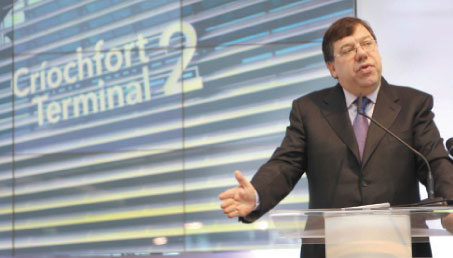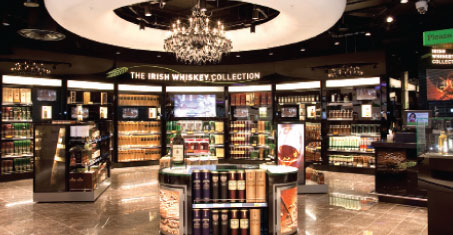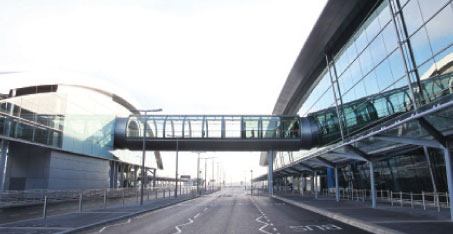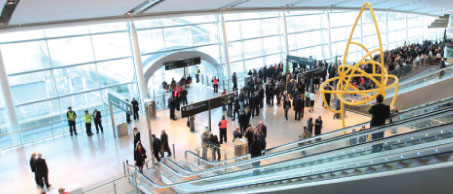
Dublin Airport’s new Terminal 2 was officially opened by the Irish Prime Minister, Brian Cowen, on 19 November.
Amidst international media interest, Brian Cowen, Prime Minister of Ireland, opened the new 75,000sqm facility as the inaugural Aer Lingus flight arrived from Manchester.
Following the opening, airlines are now transferring their operations to the new facility on a staggered basis. Etihad Airways has already transferred its entire Dublin operation to Terminal 2, while Aer Lingus will begin a full transfer of operations from January. The United States Customs and Border Protection (CBP) authorities are also expected to transfer to Terminal 2 in the New Year with the transatlantic carriers then following suit.
As one of the biggest construction projects ever undertaken in the Irish Republic, Terminal 2 was delivered at a cost of approximately €600 million and Collier outlined that it will make a drastic difference to the long-term future of Dublin Airport.
“Terminal 2 delivers a step-change in facilities at Dublin Airport that our passengers and customers will enjoy for many years to come” he said. “The core benefit that T2 delivers is the improvement in the travel experience for the entire Dublin Airport campus. Our customers have been asking us for new and improved facilities for many years and we have now delivered them.”
“There are also a number of airlines that have been interested in serving the Dublin market for many years, but have previously taken a view based on our facilities. With the advent of T2, we have radically improved the product across the entire airport campus and I am confident that this will enable Dublin Airport to win significant new business over the long-term.”

Innovation and entertainment are two key components in the 8,500sqm retail offering and this is apparent in the likes of The Irish Whiskey Collection, the Slaney Bar and the Chocolate Lounge.
The CBP (Customs and Border Protection) facilities are also a major USP (unique selling point). Allowing passengers to clear US Customs and Immigration before boarding their flight, this means that they will be treated as domestic passengers on arrival in the US. The only other European airport that offers this facility is the DAA-operated Shannon Airport.
In addition to the construction of the terminal building itself, the new 24,000sqm Pier E has also been built to provide parking for up to 19 short-haul or eight long-haul aircraft.
For the overall Terminal 2 project, Mace was appointed to the design team in the role of construction manager as part of a three-way partnership alongside Arup and Pascall+Watson architects.
Throughout the construction process, a number of challenges had to be addressed to ensure that the delivery of the terminal adhered to the DAA’s stringent safety requirements and also satisfied each stage of the timeframe.
With the project taking place within the live airport environment, the work had to be phased and coordinated with all parties involved, while for the construction taking place airside, a restricted zone had to be built to ensure that the work was carried out both efficiently and securely.
Despite this, the construction of the terminal, along with the delivery of 83,000sqm of aircraft pavement, 17,000sqm of landside forecourt and 3.5km of road, was completed in a timeframe of just 31 months.
Long-term importance
The DAA has been faced with an increasingly difficult economic climate both during construction and upon the opening of the terminal. Despite this, the Airport Authority is keen to stress that the investment should be viewed very much as part of the long-term development of Dublin Airport and the wider Irish aviation industry.
Collier explained: “When you build airport infrastructure, you have to take a long-term view. This terminal is built with a 40-year timeframe and in that context the current economic downturn is a very short-term issue.”
“Studies show that aviation traffic recovers after every major economic or geopolitical shock and that will be the case with the current downturn. It is also important to realise that Ireland is an open export-driven economy with no land link to the rest of Europe. For us, airport infrastructure is vital and Dublin Airport is the key gateway for the Irish economy. For this reason, T2 is hugely important for the overall Irish economy and the new terminal and its associated infrastructure is a €600 million investment in Ireland’s future.”

As well as the construction of the terminal building itself, 83,000sqm of aircraft pavement, 17,000sqm of landside forecourt and 3.5km of road were also delivered in just 31 months.
Commercial development
As the DAA seeks to further explore opportunities to increase its non-aeronautical income, Terminal 2 includes a wide-ranging retail offer. Under the retail brand ‘The Loop’, a combination of high-end fashion brands, a diverse F&B selection and unique local brands are present. While the average passenger dwell time in the retail area in Terminal 1 is nine minutes, the DAA’s aim is to double this for Terminal 2.
Neeson explained: “Non-aeronautical revenues are absolutely critical to the DAA. The landing charges at Dublin Airport are among the lowest in Europe and well below what you’d expect for an airport of this size. Generating commercial revenue is critical not just in terms of contributing to the cost of this new facility, but also for developing future business for the DAA.”
Among the brands on offer in the 8,500sqm of dedicated commercial space are the likes of Azure, Hugo Boss, Jo Malone and House of Ireland, and the “DAA’s price commitment is that we will never be beaten by downtown prices or the passenger is entitled to double the difference”.
Having undertaken detailed customer research throughout the development process, innovation and entertainment were two key areas that were pursued and these facets are apparent in the likes of The Irish Whiskey Collection, the Slaney Bar and the Chocolate Lounge.
“We’re very proud of the retail offering,” Neeson added, “and we’ve tried to make it very customer focused. The Slaney Bar offers magnificent views across Dublin and the idea is to give passengers the opportunity to sit down and relax. The Chocolate Lounge includes a conveyor belt of food, so for those travelling in the morning, this will include muffins, muesli and so on, and the product will then become more decadent as the day goes on. It’s completely designed to suit the needs of the passengers.”

Terminal 2 covers an area of 75,000sqm and was constructed at a cost of approximately €600 million.
Future vision
While the foundations are now in place to support both aeronautical and non-aeronautical business development, the DAA also has a longer-term vision, which outlines the ambitious plans for Dublin Airport over the next few decades.
“Our ultimate long-term vision for Dublin Airport would be to grow traffic to up to 50 million passengers per year with the addition of a new parallel runway, as well as additional pier and terminal facilities,” Collier explained. “Unlike many major European airports, we have the capacity to add a new runway and due to the foresight of airport planners in the 1960s and 1970s, we have the required land to expand.”
While such expansion may currently be a long way off, the DAA’s continued investment, even in such precarious economic circumstances, pays testament to its dedication to ensuring long-term, sustainable growth.







